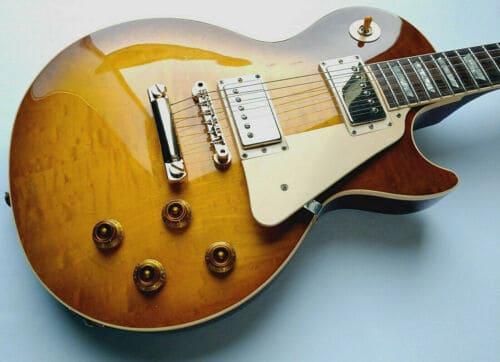Although Les Pauls were traditionally made with mahogany, modern takes on the model are known to use many different materials.
In some cases, this can be with the intention of substituting the original tonewood for a cheaper one, while in others just a way of pushing the envelope and getting away from tradition.
But what is actually the best wood for a Les Paul?
Original Les Pauls were made of mahogany, maple, and rosewood. These materials were selected mainly because of their availability and quality in the late ’50s. Nowadays, it’s harder to find high-quality specimens of these woods, so manufacturers gravitate to alternative ones such as okoume.
In this article, I will tell you all you need to know about what makes a Les Paul sound like a Les Paul, and what alternatives might get you close to it.
After leaving this page you will have a clearer idea about how tonewoods work on a Les Paul, what is the traditional take on the instrument, and what things you should look for when shopping for a great guitar.
Are you ready to get started?
Let’s go!
What makes for a great tonewood
Although tonewoods are debated among guitar players, especially for electric guitars, I’m a big proponent that they actually do make a difference.
However, we are not here to discuss that now.
Assuming that tonewoods are important for a guitar, it’s only natural to also accept that there might be different “qualities” of them in the wild.
And, although this quality I mention can be used to rank specific types of wood, or species (or anyway it should be said) such as Mahogany, Maple, Cedar, Rosewood, etc. or their different local variants (Indian Rosewood, Brazilian rosewood) I also think about it within slabs of the same kind.
You see, you can find two pieces of comparable trees of mahogany, however one has been cut very recently and the other one was stored for 70 years.
In this case, you can expect that the older exemplar will probably be way better “stationed”, dryer, and more resonant for the use on a guitar.
This is a big tradeoff a lot of manufacturers have to think about nowadays with the current availability of woods, but I will touch on this later.
Legendary Les Pauls were built with mahogany, maple, and rosewood
As you might know, the original Les Paul was made with mahogany for the body and neck, maple for its top, and rosewood for the fretboard.
Was this the result of thorough experimentation and research until Gibson and Les Paul himself found the perfect combination in terms of tone and playability?
Probably not, however, I do think they empirically knew what they were doing.
Original guitar models were mostly made with what was available at the moment, and not with what looked or sounded more exotic.
This selection (or given set) of materials put together in this guitar ended up shaping the sound of lots of legendary records and casting in our brains what great Les Pauls should sound like.
But is this all Les Pauls should be?
The case for Okoume
Okoume is a hardwood native to Africa that’s commonly used as an alternative to mahogany.
It has a slightly brighter tone, particularly in the upper midrange, but this probably will be hard to notice on an electric guitar.
Many purists will turn away from “modern” alternatives such as this, but when the choice is to be made between a very young piece of mahogany or a well-stationed slab of Okoume, I would always go for the more mature alternative.
Other alternatives
Not only Okoume is nowadays used as a replacement for mahogany in many guitar models that don’t intend to be a truthful reissue of their classic counterparts.
It’s common to also find necks and bodies made of korina, koa, wenge, agathis, bubinga, walnut, and even basswood.
Pau ferro, baked maple, laurel, and even synthetics such as richlite can also be found as fingerboard tonewoods.
Is there anything wrong with this?
Again, not really.
It’s just a slightly different flavor, and for electric guitars such as the Les Paul, one could argue it might be even more of an aesthetic choice.
Quality vs availability
As I mentioned earlier, these days, with mass production in mind, manufacturers and artisans have to deal with a ubiquitous tradeoff between quality and availability.
Making a guitar with its vintage old specs it’s not economically possible in many cases, and in some others, not even legal.
From finishes to certain protected kinds of woods, manufacturers have to make compromises to deliver goods at a payable price point.
Mahogany is an expensive tonewood, and its demand has only grown with the years and its popularity as a material for luxury furniture.
This only causes available stocks to be young and not really well-fitted for guitar making.
A completely different scenario from what Gibson had to deal with in the late ‘50s when the Les Paul was first prototyped.
One could argue that if such a guitar was designed in the current times, its builders will probably gravitate to some alternative kind of wood that is currently commonly available in conditions suited for guitar-making, such as the ones mentioned above.
Conclusion
There is no best wood for a Les Paul since it mostly depends on the quality of the current slabs available. When the original runs were made, mahogany, maple, and rosewood were a great alternative, however, nowadays their quality is lacking. This is why manufacturers use substitute materials.

Hello there, my name is Ramiro and I’ve been playing guitar for almost 20 years. I’m obsessed with everything gear-related and I thought it might be worth sharing it. From guitars, pedals, amps, and synths to studio gear and production tips, I hope you find what I post here useful, and I’ll try my best to keep it entertaining also.





